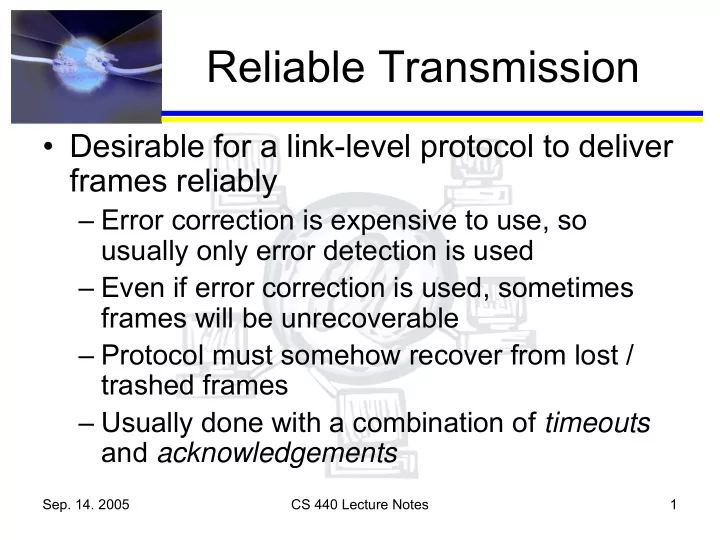

Reliable Transmission • Desirable for a link-level protocol to deliver frames reliably – Error correction is expensive to use, so usually only error detection is used – Even if error correction is used, sometimes frames will be unrecoverable – Protocol must somehow recover from lost / trashed frames – Usually done with a combination of timeouts and acknowledgements Sep. 14. 2005 CS 440 Lecture Notes 1
Automatic Repeat Request (ARQ) Mechanism • Receiver sends short acknowledgement (ACK) to indicate it has received a frame – May be able to piggy-back the ACK on another frame of data that is being sent back to sender • If sender doesn’t receive ACK within some timeout period, it retransmits the frame • Three different ARQ algorithms – Stop-and-Wait – Sliding Windows – Concurrent Logical Channels Sep. 14. 2005 CS 440 Lecture Notes 2
Stop-and-Wait Algorithm • Sender transmits one frame, starts timer, and waits for acknowledgement • If timer counts down, sender retransmits • Four basic scenarios: Receiver gets message, sends Frame Receiver Timeout Sender ACK, and it is received and understood by sender within timeout ACK Sep. 14. 2005 CS 440 Lecture Notes 3
Stop-and-Wait (cont.) • Receiver never gets message. Frame Receiver Timeout Sender Sender times out, retransmits, and receiver succeeds in returning ACK within timeout Frame Timeout ACK Sep. 14. 2005 CS 440 Lecture Notes 4
Stop-and-Wait (cont.) • Receiver gets message and ACKs, Frame Receiver Timeout Sender but ACK is lost. Sender times out, retransmits, and receiver succeeds in returning ACK within timeout. ACK Frame Timeout ACK Sep. 14. 2005 CS 440 Lecture Notes 5
Stop-and-Wait (cont.) • Receiver gets message and ACKs, Frame Receiver Timeout Sender but ACK does not arrive before timeout. Sender retransmits, and receiver succeeds in returning ACK ACK within timeout. Frame Timeout ACK Sep. 14. 2005 CS 440 Lecture Notes 6
Stop-and-Wait (cont.) • Receiver might get duplicate copies of message (third and fourth scenarios), so it must be able to identify them – Add a one-bit sequence number to the frame, so that receiver can tell if a frame is a retransmit or a new one – Add the same bit to the acknowledgement - have ACK0 and ACK1, so the sender knows exactly which frame was being acknowledged Sep. 14. 2005 CS 440 Lecture Notes 7
Stop-and-Wait Drawbacks • Protocol only allows one outstanding frame at a time. If there is high latency on the link, this is extremely inefficient – Suppose link has bandwidth of 1 Mbps and RTT of 50 ms. Delay x bandwidth = 50 Kb ≈ 6 KB – If average frame length is 1 KB, you are only using 1/6 of the link capacity You cannot keep the pipe full without having 6 frames outstanding at a time Sep. 14. 2005 CS 440 Lecture Notes 8
Sliding Window • Addresses the problem with stop-and-wait by allowing multiple frames to be in transit at the same time • Each frame is assigned a sequence number (more than the 1-bit number used in stop-and- wait). • Sender maintains three values: – Send Window Size – Last Acknowledgement Received – Last Frame Sent Sep. 14. 2005 CS 440 Lecture Notes 9
Sliding Window (cont.) • Require that LFS – LAR ≤ SWS at all times – Can’t ever have more than SWS unacknowledged frames outstanding • Once sender has sent SWS frames, cannot send more until one is ACKed and LAR increases Sep. 14. 2005 CS 440 Lecture Notes 10
Sliding Window (cont.) • Receiver also maintains three values: – Receive Window Size – Largest Acceptable Frame – Last Frame Received • Require that LAF – LFR ≤ RWS always • Receiver rejects any frame with sequence outside range (LFR, LAF] Sep. 14. 2005 CS 440 Lecture Notes 11
Sliding Window (cont.) • When receiver gets a good frame, it must decide whether to ACK – Should ACK frame with largest seq # such that all frames with smaller seq #s have been received (i.e. the last frame before a hole) – Can then bump LAF and move window forward Sep. 14. 2005 CS 440 Lecture Notes 12
Sliding Window Optimizations • Desirable to detect packet loss as quickly as possible – Send negative acknowledgement (NAK) for missing packet when hole in window detected – Resend ACK for last frame before hole – Use selective acknowledgements that can include multiple seq #s • All of these changes complicate protocol Sep. 14. 2005 CS 440 Lecture Notes 13
Sliding Window (cont.) • Window size indicates how many frames sender or receiver must buffer – SWS and RWS don’t necessarily need to be the same – No point making RWS > SWS • Practical implementation issue – Infinitely large seq #s don’t fit in a finite number of bits very well Sep. 14. 2005 CS 440 Lecture Notes 14
Finite Sequence Numbers • Limit max seq # to some value (a power of 2 – 1) • Need SWS < (max seq num + 1) / 2 so that there is no possibility of receiver confusing retransmitted frame with new frame – Choose desired SWS based on expected delay x bandwidth and frame size; this will indicate number of bits required for seq # Sep. 14. 2005 CS 440 Lecture Notes 15
Frame Order and Flow Control • Sliding Window Protocol does three things: – Reliably deliver frames across link – Keep the frames in order – Provide flow control ; allows receiver to control the rate at which sender generates frames • Add # frames receiver can take to acknowledged seq # in ACK msg Sep. 14. 2005 CS 440 Lecture Notes 16
Concurrent Logical Channels • ARPANET data link protocol • Idea is to multiplex several logical channels over single data link, using a stop-and-wait protocol on each logical channel • Keeps pipe full, but doesn’t maintain order, because there is not necessarily any relationship between different channels Sep. 14. 2005 CS 440 Lecture Notes 17
Recommend
More recommend